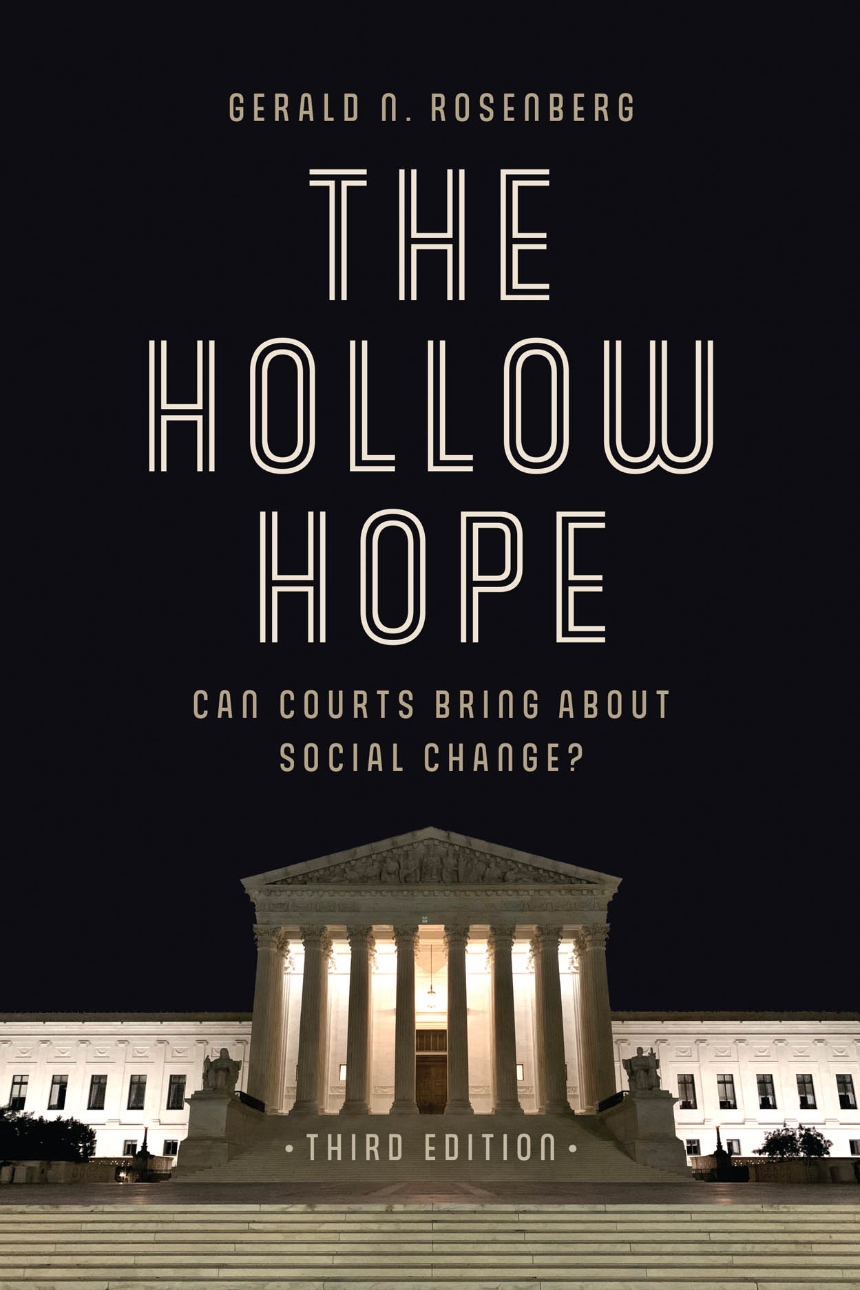The Hollow Hope
Can Courts Bring About Social Change?
Third Edition
9780226312477
9780226312330
9780226312507
The Hollow Hope
Can Courts Bring About Social Change?
Third Edition
Presents a powerful argument for the limitations of judicial action to support significant social reform—now updated with new data and analysis.
Since its first publication in 1991, The Hollow Hope has spurred debate and challenged assumptions on both the left and the right about the ability of courts to bring about durable political and social change. What Gerald N. Rosenberg argued then, and what he confirms today through new evidence in this edition, is that it is nearly impossible to generate significant reforms through litigation: American courts are ineffective and relatively weak, far from the uniquely powerful sources for change they are often portrayed to be.
This third edition includes new data and a substantially updated analysis of civil rights, abortion rights and access, women’s rights, and marriage equality. Addressing changes in the political and social environment, Rosenberg draws lessons from the re-segregation of public schools, victories in marriage equality, and new obstacles to abortion access. Through these and other cases, the third edition confirms the power of the book’s original explanatory framework and deepens our understanding of the limits of judicial action in support of social reform, as well as the conditions under which courts do produce change. Up-to-date, thorough, and thought-provoking, The Hollow Hope remains vital reading.
Since its first publication in 1991, The Hollow Hope has spurred debate and challenged assumptions on both the left and the right about the ability of courts to bring about durable political and social change. What Gerald N. Rosenberg argued then, and what he confirms today through new evidence in this edition, is that it is nearly impossible to generate significant reforms through litigation: American courts are ineffective and relatively weak, far from the uniquely powerful sources for change they are often portrayed to be.
This third edition includes new data and a substantially updated analysis of civil rights, abortion rights and access, women’s rights, and marriage equality. Addressing changes in the political and social environment, Rosenberg draws lessons from the re-segregation of public schools, victories in marriage equality, and new obstacles to abortion access. Through these and other cases, the third edition confirms the power of the book’s original explanatory framework and deepens our understanding of the limits of judicial action in support of social reform, as well as the conditions under which courts do produce change. Up-to-date, thorough, and thought-provoking, The Hollow Hope remains vital reading.
See Rosenberg’s response to his critics and additional materials from the second edition.
736 pages | 24 line drawings, 49 tables | 6 x 9 | © 2023
Law and Legal Studies: The Constitution and the Courts
Political Science: American Government and Politics, Judicial Politics
Reviews
Table of Contents
List of Tables and Figures
Preface to the Third Edition
Preface to the Second Edition
Preface to the First Edition
Introduction
1: The Dynamic and the Constrained Court
Part 1: Civil Rights
2: Bound for Glory? Brown and the Civil Rights Revolution
3: Constraints, Conditions, and the Courts
4: Planting the Seeds of Progress?
5: The Current of History
Part 2: Abortion and Women’s Rights
6: Transforming Women’s Lives? The Courts and Abortion
7: Liberating Women? The Courts and Women’s Rights
8: The Court as Catalyst?
9: The Tide of History
Part 3: Marriage Equality
10: You’ve Got That Loving Feeling? The Litigation Campaign for Marriage Equality
11: What a Long, Strange Trip It’s Been: Mobilization, Countermobilization, and State Action
12: The Times They Are a-Changing
13: Conclusion: The Fly-Paper Court
Epilogue
Appendixes
1. Black Children in Elementary and Secondary School with Whites, State-by-State Breakdown, 1954–1972
2. Blacks at Predominantly White Public Colleges and Universities: State-by-State Breakdown
3. Black Voter Registration in the Southern States, Pre– and Post–Voting Rights Act, State-by-State Breakdown
4. Data Correction for Table 2.5
5. Laws and Actions Designed to Preserve Segregation
6. Method for Obtaining Information for Table 4.1 and Figure 4.1
7. Illegal Abortions
8. Method for Obtaining Information for Tables 8.1a, 8.1b, 8.2a, and 8.2b, and for Figures 8.1 and 8.2
9. Make Change, Not Lawsuits
10. Coding Rules and Method for Obtaining Information for Tables 12.2, 12.3, 12.4, 12.5, and 12.6
Case References
References
Index
Preface to the Third Edition
Preface to the Second Edition
Preface to the First Edition
Introduction
1: The Dynamic and the Constrained Court
Part 1: Civil Rights
2: Bound for Glory? Brown and the Civil Rights Revolution
3: Constraints, Conditions, and the Courts
4: Planting the Seeds of Progress?
5: The Current of History
Part 2: Abortion and Women’s Rights
6: Transforming Women’s Lives? The Courts and Abortion
7: Liberating Women? The Courts and Women’s Rights
8: The Court as Catalyst?
9: The Tide of History
Part 3: Marriage Equality
10: You’ve Got That Loving Feeling? The Litigation Campaign for Marriage Equality
11: What a Long, Strange Trip It’s Been: Mobilization, Countermobilization, and State Action
12: The Times They Are a-Changing
13: Conclusion: The Fly-Paper Court
Epilogue
Appendixes
1. Black Children in Elementary and Secondary School with Whites, State-by-State Breakdown, 1954–1972
2. Blacks at Predominantly White Public Colleges and Universities: State-by-State Breakdown
3. Black Voter Registration in the Southern States, Pre– and Post–Voting Rights Act, State-by-State Breakdown
4. Data Correction for Table 2.5
5. Laws and Actions Designed to Preserve Segregation
6. Method for Obtaining Information for Table 4.1 and Figure 4.1
7. Illegal Abortions
8. Method for Obtaining Information for Tables 8.1a, 8.1b, 8.2a, and 8.2b, and for Figures 8.1 and 8.2
9. Make Change, Not Lawsuits
10. Coding Rules and Method for Obtaining Information for Tables 12.2, 12.3, 12.4, 12.5, and 12.6
Case References
References
Index
